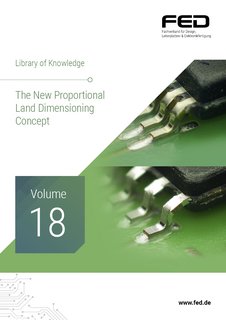The New Proportional Land Dimensioning Concept
Bibliothek des Wissens Band 18 (Englisch) - Library of Knowledge Volume 18: In addition to reliable components and circuit boards, reliable electronics require equally reliable production. Following assembly with a low placement tolerance, a flawless soldering process of the components is particularly important. This in turn requires that the lands on the circuit board match the component terminals exactly.
In the early days of SMD soldering technology it was assumed that for a reliable solder connection the soldering surfaces on the PCB should be
significantly larger than the component terminals themselves. This is still reflected today in the applicable standards of IPC-7351 and IEC 61191-2. Although repeatedly revised and adapted to the ever finer structures, the currently defined specifications and calculation methods for creating the
soldering surfaces fit less and less to the constantly changing component terminals, especially the smaller they become, above all because constant
absolute values are specified for the protrusions. For modern reflow soldering processes, these are outdated rules and measures, as practice has shown: Soldering surfaces that protrude too far generate lateral tensile forces, which in extreme cases can lead to the dreaded tombstoning (tombstone effect) in assemblies with chip components, for example, or solder bridges in multi-terminal components. So, too much solder and area can have negative effects during the soldering process. In addition, any unnecessary use of space is a considerable disadvantage, especially for densely populated assemblies with a high connection density. The constantly expanding, almost incalculable variety of component terminal
shapes, sizes and grid dimensions requires an adaptive dimensioning of the corresponding soldering surfaces for optimum solder joints. This is where the New Proportional Land Dimensioning Concept comes in: It enables the calculation of the suitable land on the circuit board in proportion, to the size of the component terminal, taking into account the physical properties of the soldering process: wetting, capillary action and force transmission. In their interaction, however, they cause the solder meniscus and coverings specified in the applicable standards under reliability aspects without unnecessarily or negatively affecting too large land areas. The starting point for the proportional concept are the requirements at solder joints as described in J-STD-001 and IEC 61191-2 on the one hand and a new simplified classification of components according to their terminal types on the other. While the IEC land pattern standards as well as the IPC-7351 differentiate the components according to package families, the proportional concept is based on a two-stage classification according to terminal types. The advantages of the New Proportional Land Dimensioning Concept are:
Easy scalable, Trouble-free adaptation also for future components, Risk minimization (e.g. bridging in paste printing, best adapted, paste volumes), Higher reliability of the solder joints (error-reduced assembly process), Proportional land pattern lead to more space for the routing process.
Free Download for FED-Members

About Rainer Taube
The initiator and inventor of the Proportional Concept, Rainer Taube, as entrepreneur and owner of TAUBE ELECTRONIC GmbH, a high-tech assembly manufacturer, recognized the necessity of a new land dimensioning concept based on his own experience years ago. The road and process to today's concept was long and rocky. He began with the intention of modifying the current IPC standard accordingly. In particular, the difficulty of converting major American DoD companies has prolonged the process and to date has not enabled a new IPC standard. At numerous meetings with Tom Hausherr, owner of PCB libraries, the IPC-FED reference calculator emerged from hours of discussions about the correct land pattern design and its calculation from the IPC-7351 Land Pattern Calculator - an EXCEL based calculation program, which allows the calculation according to the IPC-7351B algorithms as well as according to the proportional concept. This provides a tool that the FED makes available to its members for download. The Library of Knowledge, Volume 18, first explains the previous IPC Land pattern concept and then introduces the New Proportional Land Dimensioning Concept and the IPC-FED Reference Calculator and explains its use.
Additionally the FED verification project was launched in 2016 to ensure that the land areas calculated with the proportional concept result in acceptable solder joints according to the requirements of J-STD-001 and IPCA-610. In this project a testboard was designed which contains land pattern according to IPC-7351B nominal for all component types as well as land pattern calculated according to the proportional concept. For the evaluation of reliability, several circuit boards were assembled and soldered in two production facilities and then inspected and approved by an independent expert according to the acceptance criteria of the IPC-A-610. On behalf of the FED I would like to express my sincere thanks to Rainer Taube for this valuable work and also for his free time, which he has made available and continues to make available to the FED and its members free of charge. Rainer Taube has been a member of the FED since its foundation and stands by its side in word and deed without interruption ever since, currently as Board Member for the Directives and Standards Division and as Master Trainer for IPC-A-610 and Convener of IEC WG12 in the TC91, where a new standard for the dimensioning of land pattern on circuit boards is currently being developed, including the New Proportional Land Dimensioning Concept.